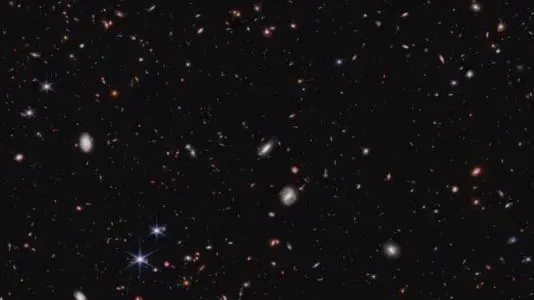
Shocking Discovery: James Webb Space Telescope Unveils Galaxies that Defy Dark Matter Theories!
2024-11-12
Author: Daniel
Shocking Discovery: James Webb Space Telescope Unveils Galaxies that Defy Dark Matter Theories!
In a groundbreaking revelation, astronomers examining data from the James Webb Space Telescope (JWST) have uncovered that some of the universe's oldest galaxies defy expectations, appearing larger and brighter than previously believed. This unexpected finding could indicate a formation process that eschews the influence of dark matter.
The study suggests a compelling shift towards an alternative theory of gravity known as modified Newtonian dynamics, or MOND. According to Stacy McGaugh, an astrophysicist at Case Western Reserve University, the impressive size of these early galaxies challenges traditional views held about their evolution through cold dark matter—our current standard cosmological model.
McGaugh remarked, “The expectation was that every big galaxy we see in the nearby universe would have started from these tiny fragments. Yet, what we observe contradicts these dark matter predictions.”
Traditionally, the gradual hierarchical model explains the evolution of galaxies, with small, primitive clusters merging over time. However, JWST's observations have not only failed to detect these supposed early fragments but have unveiled galaxies that are astonishingly large and luminous even deeper in the cosmic timeline. The research team concluded that the galaxies seem to have grown too rapidly, a phenomenon not anticipated by existing dark matter models.
To add to the intrigue, the characteristics of some exceptionally bright objects observed may be attributed to active supermassive black holes instead of galaxies. Yet, McGaugh argued that this merely shifts the enigma from an abundance of early stars to an overabundance of supermassive black holes, compounding the mystery.
MOND was originally proposed by Israeli physicist Mordehai Milgrom in 1982 as a means to explain peculiar rotations in galaxies without relying on dark matter or dark energy. MOND posits that gravity behaves differently in situations of extremely low acceleration, like at the fringes of galaxies.
Despite its intriguing premises, MOND faces skepticism within the astrophysical community, primarily due to challenges in integrating it into a unified theoretical framework that accounts for varied cosmological phenomena. Meanwhile, the dark matter framework, while fitting a range of observations, fails to address certain behaviors predicted by MOND.
In their recent paper published in The Astrophysical Journal, McGaugh and his co-authors articulated the dilemma within astrophysics: “We find ourselves caught between two very different theories that seem irreconcilable despite applying to closely related yet disparate lines of evidence.”
While MOND remains less mainstream within cosmology, the researchers advocate for its significance, noting that its successful predictions cannot be mere coincidence. “It must be telling us something,” they posit, leaving the door open for future research that could either confirm or further challenge our understanding of the cosmos.
As scientists continue to analyze the astonishing findings from the JWST, the debate around dark matter vs. alternative theories like MOND becomes increasingly heated, hinting that the heart of the universe’s mysteries might just be beginning to unravel. What does this mean for the future of astrophysics? Stay tuned, as the universe has many more secrets to reveal!


 Brasil (PT)
Brasil (PT)
 Canada (EN)
Canada (EN)
 Chile (ES)
Chile (ES)
 España (ES)
España (ES)
 France (FR)
France (FR)
 Hong Kong (EN)
Hong Kong (EN)
 Italia (IT)
Italia (IT)
 日本 (JA)
日本 (JA)
 Magyarország (HU)
Magyarország (HU)
 Norge (NO)
Norge (NO)
 Polska (PL)
Polska (PL)
 Schweiz (DE)
Schweiz (DE)
 Singapore (EN)
Singapore (EN)
 Sverige (SV)
Sverige (SV)
 Suomi (FI)
Suomi (FI)
 Türkiye (TR)
Türkiye (TR)